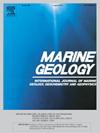北太平洋西部两千年的强烈热带气旋活动:来自海岸巨石沉积物的见解
IF 2.2
3区 地球科学
Q2 GEOSCIENCES, MULTIDISCIPLINARY
引用次数: 0
摘要
热带气旋(TCs)是最具破坏性的水动力扰动之一,但我们对其长期气候学的认识受到观测记录长度短的限制。地质记录为现代观测之前的TC活动提供了有价值的见解。尽管西北太平洋(WNP)是最活跃的TC盆地,但人们对TC强度如何响应长期气候变率知之甚少。在这里,这项研究展示了日本琉球群岛奄美-大岛海岸巨石沉积物两千年来强烈的TC活动的新记录。结果表明,在较冷的时期,包括晚古生代小冰期(LALIA);公元540-660年)和小冰期(LIA;公元1400-1700年),从寒冷期结束到温暖期活动增加,包括中世纪气候异常(MCA;950-1250 CE)和当前暖期(CWP);1850 CE-present)。综合古TC和古气候记录表明,中纬度暖期TC活动同步激活;低纬度低气压在低纬度低气压期间有所增强。这些经向反相位模式可能是由空气和海洋表面温度的变化以及哈德利环流的相关变化所驱动的。鉴于全球平均温度前所未有的上升,持续的气候变化可能会推动全球变暖行为发生重大变化,可能反映或超过过去的暖期趋势。本文章由计算机程序翻译,如有差异,请以英文原文为准。
Two millennia of intense tropical cyclone activity in the western North Pacific: Insights from coastal boulder deposits
Tropical cyclones (TCs) are among the most destructive hydrodynamic disturbances, yet our knowledge of their long-term climatology is limited by the short length of observational records. Geological records provide valuable insights into TC activity before modern observation. Although the western North Pacific (WNP) is the most active TC basin, little is known about how intense TCs have responded to long-term climate variability. Here, this study presents a new two-millennia record of intense TC activity from coastal boulder deposits on Amami-Oshima Island in the Ryukyu Islands, Japan. The results indicate reduced TC activity during colder periods, including the Late Antique Little Ice Age (LALIA; 540–660 CE) and the Little Ice Age (LIA; 1400–1700 CE), and increased activity from the end of cold periods to warm periods, including the Medieval Climate Anomaly (MCA; 950–1250 CE) and the Current Warm Period (CWP; 1850 CE–present). Our integration of paleo-TC and paleoclimate records shows that TC activity had been synchronously activated during warm periods at middle latitudes in the WNP; however, it had been enhanced during the LIA at low latitudes. These meridional anti-phase patterns are likely driven by the variability in air and sea surface temperature and associated shifts in the Hadley circulation. Given the unprecedented rise in global mean temperature, ongoing climate change may drive significant changes in TC behavior, potentially mirroring or exceeding past warm-period trends.
求助全文
通过发布文献求助,成功后即可免费获取论文全文。
去求助
来源期刊

Marine Geology
地学-地球科学综合
CiteScore
6.10
自引率
6.90%
发文量
175
审稿时长
21.9 weeks
期刊介绍:
Marine Geology is the premier international journal on marine geological processes in the broadest sense. We seek papers that are comprehensive, interdisciplinary and synthetic that will be lasting contributions to the field. Although most papers are based on regional studies, they must demonstrate new findings of international significance. We accept papers on subjects as diverse as seafloor hydrothermal systems, beach dynamics, early diagenesis, microbiological studies in sediments, palaeoclimate studies and geophysical studies of the seabed. We encourage papers that address emerging new fields, for example the influence of anthropogenic processes on coastal/marine geology and coastal/marine geoarchaeology. We insist that the papers are concerned with the marine realm and that they deal with geology: with rocks, sediments, and physical and chemical processes affecting them. Papers should address scientific hypotheses: highly descriptive data compilations or papers that deal only with marine management and risk assessment should be submitted to other journals. Papers on laboratory or modelling studies must demonstrate direct relevance to marine processes or deposits. The primary criteria for acceptance of papers is that the science is of high quality, novel, significant, and of broad international interest.
 求助内容:
求助内容: 应助结果提醒方式:
应助结果提醒方式:


